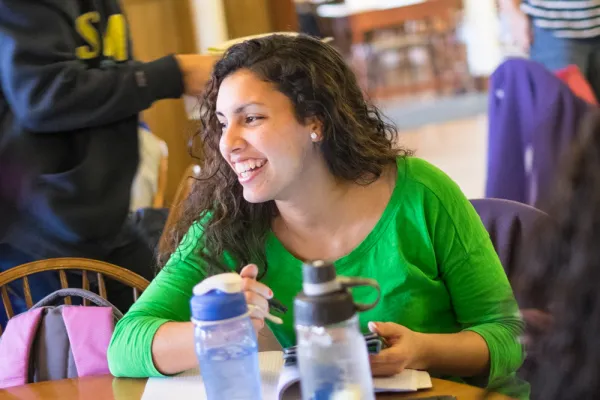What’s on the Menu for Fall Dining?
Campus Life
Published August 18, 2021
More hours. More options. More flexibility. More local food.
Those are some of the changes coming to Smith’s dining program this fall, as the college learns from alterations made during the pandemic—and adapts to students’ changing needs.
“We’re always looking for opportunities to improve our offerings,” says dining services lead Andy Cox, executive director of auxiliary services. “And we’re always listening to student feedback. This year, we’re excited to be able to offer positive changes in a number of areas.”
Some of this year’s changes were motivated by health concerns, which compel a “hybrid” approach to dining (as well as a hybrid approach to many other things!).
But the dining changes are informed, first and foremost, by what students want. “We got a lot of good feedback last spring,” Cox says, “about what was working and what was not. And we also looked back to the important work of the Residential Experience Working Group,” which took a deep dive into dining in 2019. “Some of the students who participated in that committee’s work are still here,” Cox notes. “And those student voices really matter.”
So, informed by student feedback, what’s on tap for dining this year?
- Increased availability—in a variety of locations, and for extended hours. Students are busy. They want to eat what, when, and where they want to eat. So food will now be available in at least one location on campus for a total of 15 hours a day—from 7:30 a.m. to 10 p.m. daily. So students who want to grab an early lunch before class or enjoy a late-night nosh with friends after an evening event will now have someplace on campus to go. The college also has increased the number of retail outlets on campus—the new Compass Cafe at Neilson Library supplements the Campus Center Cafe—and is quadrupling the amount of Dining Dollars that students receive (from $25 per year to $100 per year) to spend in those locations. This increased availability has a pandemic-safety benefit, too, as it helps spread out demand and density throughout the day.
- A hybrid delivery approach that allows students to choose what works best for them. Seated meals in the dining halls. Grab-and-go meals. Advance ordering through GrubHub. All options are available, giving students the ability to shape their own dining experience. “We know that variety and flexibility are important to students,” Cox says. “The way you want to eat on a Tuesday night may be very different from the way you want to eat on Sunday morning.” The new, hybrid model allows students to choose what they need in the moment.
- More vegan and vegetarian choices—not just in one “vegan dining hall,” but throughout all of Smith’s dining halls. And more local food, too. Gone are the days of a “meat and three”—a protein-centered plate with vegetables on the side. In many cases, today’s plate starts vegan, with an option to add dairy and protein at the end. The college has been working with the Humane Society to develop vegan recipes, and has signed Forward Foods’ commitment to reduce meat consumption by five percent every year. The focus, too, remains on local food, as it has for many years at Smith. “Local food is higher quality, it’s more sustainable—and it’s what students want,” Cox notes.
There are some shifts, to be sure. For example, using a data-driven approach, the college has closed three underused dining halls (in Hubbard, Wilson and Northrop/Gillett) in order to open flexible retail space in the library, significantly extend dining hours in other locations, and expand dietary options for students with medical and religious needs. Students will now need to swipe their meal cards (a practice that had fallen out of habit in recent years); and, due to the pandemic, guests are no longer allowed at meals. Campus Center Cafe weekend hours have been reduced slightly—but Neilson’s Compass Cafe is now open for brunch/lunch daily.
Overall, Cox and his colleagues are energized by the changes. “I’m excited to be able to offer vegan options everywhere,” Cox says, “and the staff is really enjoying experimenting with new recipes. We’ll now have food available for most of the day—so I’m excited to see how busy it will be at 4 p.m., or 8 p.m. And the new meal plan verification system that we’ve implemented has really helped reduce food waste.”
And, as always, staff are eager for student feedback. “Food is important,” Cox says. “We’re always looking for ways to improve.”
